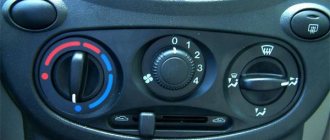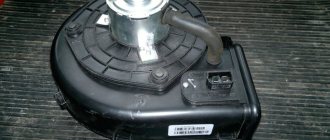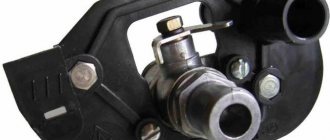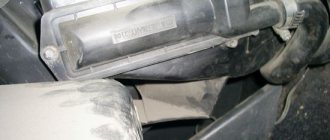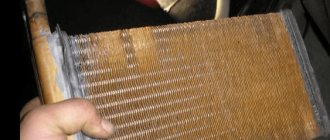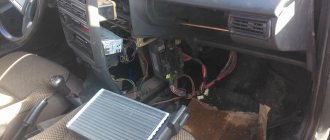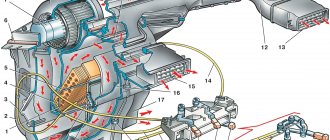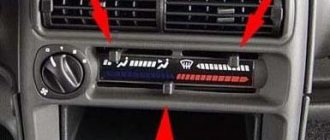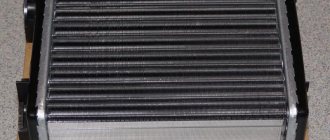If the VAZ-2114 stove does not work, this may not cause any special problems in summer and spring. But during the cold season, the lack of heat inside the cabin significantly affects the level of comfort. Do not forget that in the spring and summer the ventilation functions are partially assigned to the stove. So a stove that properly performs its tasks is an important component for every VAZ-2114 owner.
Device
If the stove suddenly starts blowing cold air or a leak develops, you must immediately begin work to detect and correct the breakdown. But in order to understand the essence of prevention and repair, you first need to understand the structure of this unit.
The interior heater includes the following elements:
- Radiator;
- Special pipes through which liquid circulates;
- Fluid circulation level adjustment valve;
- Dampers to control air flows;
- Air ducts;
- Electric fan.
If each of the units works properly, then the hot air flows will move freely through the system, exit into the cabin and blow in the direction specified by the driver.
WE FIX THE PROBLEM OURSELVES
This also happens - at high speeds the stove “breaks through” and it starts to heat up, but at idle speed the fan blows cold air. Why doesn't the VAZ 2114 heater heat up at idle? We immediately note that if you are the owner of a VAZ 2113 or VAZ 2115, then all solutions to problems with the lack of heating of the interior will be similar to the solutions with the 2114 model. So, we are trying to find simple solutions to the problem ourselves:
- Insufficient coolant level. Add antifreeze; if the stove breaks, the problem is solved.
- Airlock. How to check? In the area of the heater radiator, the characteristic murmur of antifreeze is heard, the temperature sensor on the instrument panel shows almost maximum (almost boiling), one of the main radiator pipes is cold. You need to remove the expansion tank cap, press on the pipes and “gas” the engine. Perhaps the plug will break. It happens that the valve itself in the tank plug is to blame; you can try replacing it. It is also often advised to park the car on a hill, with the plug removed, “gas” the engine, and then add antifreeze when the plug “breaks”.
- Also, if one of the pipes is cold and the temperature on the sensor goes off scale, a faulty thermostat is to blame. It's easy to check. We remove and place the thermostat in a container of water, heat the water and see at what temperature the thermostat valve begins to close. It should open at engine operating temperature (90-95ºC). The faulty part needs to be replaced.
- The head gasket begins to burn out. With such a malfunction, an air lock is created in the cooling system, but it will not be possible to expel it using all known methods. The gasket will have to be changed. True, not every car enthusiast can do such work with his own hands.
Removing the thermostat
Reasons for decreased performance
Despite the simplicity of the design, problems with the VAZ-2114 stove often arise. They are mainly associated with a drop in the performance of the heating system - the stove heats the air poorly, blows cold or slightly warm air. In this case, the reasons for poor operation of the stove can be both general (warming up is weak at any control unit settings) and when operating in a certain mode, for example, at idle. Or, for example, cold air or slightly warm air blows only on the side windows, and in other modes the heating works normally.
Common reasons why the stove stops heating:
- the heater radiator is clogged or an air lock has formed in it;
- when switched to heating mode, the heater damper does not fit tightly to the body, which is why part of the air flow moves bypassing the radiator and enters the cabin cold;
- the tap does not open completely - this is one of the main reasons for a poorly heating stove;
- the formation of cracks at the joints of the housing and air ducts, which causes strong dispersion of the air flow.
It is not difficult to determine the cause of a general decrease in the efficiency of the heating system. To find out why the VAZ-2114 stove does not heat well, you need to remove the side decorative panels from the center console, and then warm up the engine and turn on the stove at maximum power. After this, we try the antifreeze supply pipe to the heater radiator up to the tap and behind it. The same heating temperature of the tube on both sides indicates that the tap is working properly and the problem lies in the radiator. If after the tap the pipe is less warmed up, the tap is jammed or does not open completely.
After this, we determine the temperature at the inlet and outlet pipes of the radiator. If the heat exchanger is not clogged and there is no plug in it, then the temperature of the outlet pipe will be lower than the inlet pipe. But if the outlet tube is cold, antifreeze does not circulate through the radiator, which indicates the formation of an air lock (airing) or clogging.
A common cause of failure of the VAZ-2114 stove is wear and play in the sliders. Because of this, even when they are moved to their extreme positions, the cables do not bring the valve and dampers to the stop (the valve remains closed, and the dampers do not block the air flow channels). This problem can be easily resolved - you need to make an adjustment and shorten the cables a little.
The problem of insufficient heating of one of the zones is associated with a violation of the damper control. This happens due to the same wear on the sliders, the cable jumping off the damper levers, the damper axes jumping out of the seats in the body, which is accompanied by clicks.
In addition to weak warming up, VAZ-2114 car owners are faced with the fact that the intensity of air flow decreases. This happens due to the dispersion of air through the cracks at the junction of the body and air ducts, clogging the latter with debris - many owners do not install cabin filters, so leaves get into the air ducts and interfere with air movement.
Why does it blow cold on the windshield?
The supply of heated air in this location is regulated by a special damper. It is driven by a cable, which on a VAZ is generally stretched very often. This, in turn, leads to the fact that the damper itself does not open fully. In such a situation, air will be supplied inside the car directly from the street, that is, cold.
Understanding the principle by which heating functions in the VAZ-2114, it is generally not difficult to find out what the actual problem is. But even an experienced car enthusiast will need a lot of time to fix it. The thing is that the stove itself is located directly behind the panel located in the front of the cabin, near the steering wheel - troubleshooting requires its dismantling.
The problem with the cable is most noticeable when the temperature control is turned downward (that is, to the left).
Repairing heating in general is quite easy. You should proceed in this order:
- The cover under the steering wheel on the left is removed;
- the cable itself and its fastening are found near the gas pedal;
- the clamp is dismantled;
- the cable is tightened so that it does not sag;
- fixed with the same clamp;
- the damper control levers move (left to right all the way and vice versa);
- The tap regulator is set to maximum.
After this, the ignition is turned on and very soon fairly hot air begins to blow from the previously blocked holes. As practice shows, these manipulations help get rid of the problem in virtually all cases.
To eliminate this mess, you will need to remove the cable of the damper mentioned above from the heating regulator. This is done as follows:
- remove the cover on the right side of the steering column;
- the regulator drive is found there (it has 2 cables);
- the one to the right is unhooked;
- the dismantled cable is tensioned so that the damper moves to the position of maximum heating of the interior;
- the resulting excess piece is cut off after fixing it in the old place, with a margin of no more than one and a half centimeters.
After this, the stove should work fully, and adjusting the temperature will be easy and comfortable.
Causes of malfunctions
In winter, when the cabin heater stops working, you feel discomfort: it is cold in the car and the windows freeze. To figure out why the stove on the VAZ-2114 does not work, the car should be driven into the garage.
Additionally, we recommend reading the article by our specialist, which describes how the on-board computer of the VAZ-2114 works.
Before starting work, you need to become familiar with the structure of the vehicle's heating system. The structure consists of the following elements:
- heater radiator;
- pipes supplying heated coolant;
- faucet that regulates the flow of liquid;
- interior dampers directing the air flow;
- a fan that creates air flow;
- fan speed controller;
- a pump that creates a flow of heated liquid;
- thermostat, which is responsible for the direction of movement of the coolant.
When all these elements function normally, the car interior is warm. But when one of them stops working, interruptions in heating occur.
If the fan of the VAZ-2114 heater does not work, the reasons most often given by auto mechanics are the following:
- fan failure;
- fuse blown;
- lack of contact in the electrical circuit;
- heater radiator malfunction;
- The thermostat does not respond to temperature changes;
- faucet breakdown;
- low pressure in the coolant circulation system;
- airlock;
- The engine cylinder head gasket was blown.
We recommend: How to change the oil filter without changing the oil?
We also recommend reading our expert’s article, which talks about how to change the heater radiator on a VAZ-2110.
Heater maintenance
To ensure that the VAZ-2114 heater heats well in winter, carry out maintenance of the heater before the cold weather:
- Remove it from the car.
- Disassemble and clean.
- Check the functionality of the dampers, seal their ends with sealants.
- Seal the joints with sealant.
- Flush the radiator.
- After assembly, adjust the drive cables so that when moving the sliders, the valves and the tap become in their extreme positions.
These measures are enough for the heating system to function normally in winter, providing warmth to the car interior.
Finally, we note that the reasons for the poor operation of the stove were discussed above, but it still continues to function. But this unit also has breakdowns and then the stove fails and stops working completely. Such reasons include breakdown of the radiator, leaks at the joints of the pipes, fan malfunction (open circuit, exhausted motor life or burnout).
Owners of domestic vehicles, for example, such as the VAZ 2114, periodically encounter a problem that appears in winter - the heater stops functioning properly. Problems may result in the fact that warm air stops coming from the stove or the motorist will not be able to turn on the heating unit at all. Therefore, in such a situation, when the windshield of a vehicle is covered with a layer of dense ice “blanket”, which obstructs normal visibility, the motorist must know how to act correctly at such a moment. In view of this, if problems arise with the heater, you must first understand the structure of the system and know the circuit diagram of the unit, which will help find the cause of the malfunction.
Preventing the operation of the stove in the car
In order for the stove in your car to heat well and not let you down at the most inopportune moment, you need to follow a few simple tips.
- Keep the radiator clean. Light contamination from the outside of the radiator can be removed with a vacuum cleaner. Flushing the engine cooling system, with which the heater radiator is inextricably linked, will help get rid of internal deposits and blockages in the channels.
- Use good antifreeze . High-quality antifreeze is the key to long-term operation of not only the stove in the car, but also the engine. Remember this and do not forget to replace it in a timely manner.
- Change the cabin filter more often . A clogged cabin filter will certainly create problems not only for the operation of the stove, but also for the air conditioning and cabin ventilation system as a whole. In addition, dust and pollen deposited in the filter can pose a serious health hazard (especially for allergy sufferers).
If, at an outside temperature of minus 25 °C, your car’s heater heats the interior to +16 °C from below and up to +10 °C from above, then it can be considered quite serviceable. To avoid problems, it is recommended to carry out preventive measures in a timely and responsible manner that will allow you to enjoy a comfortable ride in a well-warmed-up car.
And remember, the longer the service life of the machine, the more attention its heating system requires. This applies to all cars, regardless of country and manufacturer.
Causes of poor-quality stove operation
Based on the complex structure of the stove, it becomes clear that it may not work correctly for many reasons. A malfunction of at least one of the components and components of the heating system can lead to a malfunction of the stove. In this case, a malfunction may occur due to the driver’s fault, or it may be a consequence of aging or incorrect operation of other vehicle systems.
Problems with the stove can manifest themselves in the following ways:
- Poor interior heating.
- Cold air from the stove.
- Variable temperature of air supplied from the stove.
- Weak flow of hot air from the stove.
- The heater in the car does not turn on.
Knowledge of the structure of the stove itself and possible breakdowns will make it possible to avoid large expenses when repairing a car. Let's look at the most common causes of poor-quality stove operation below.
Fan doesn't work
A fan malfunction can often be one of the problems with heating the interior. The cause of this failure is usually damage to the bearings or graphite brushes, which may require complete fan replacement. Also, the fan may be faulty due to the blown fuse or relay in the electrical power circuit, which is also a reason to contact a car service center.
If the fan makes a whistle during operation, and its rotation speed changes from minimum to maximum and vice versa, then the cause of the problem may be a failure of the fan motor. In such conditions, the radiator may remain hot, but it will not be possible to warm the interior to the desired degree.
Insufficient coolant level
A malfunction of the stove can be caused by a coolant leak, as a result of which heat stops flowing into the cabin radiator in the required volume. This in turn leads to a decrease in the volume of antifreeze in the expansion tank. To fix the problem, you need to find the location of the leak, add antifreeze to the expansion tank, and sometimes it may be necessary to replace the coolant supply valve.
Engine pump faulty
The pump is used to circulate antifreeze and to ensure proper functioning of the stove. If such a pump breaks down, a malfunction may occur in many engine components, including the vehicle interior heating device.
A malfunction of this part can be caused by wear on the inside of the impeller, a broken crankshaft belt, or even jamming of the pump itself. It is better to eliminate this kind of problem by completely replacing the pump, and to avoid such breakdowns, it is recommended to regularly check the hose leading to the pump, and also listen to sounds under the hood.
Blown engine head gasket
The head gasket is designed to connect the block and the car engine head itself, ensuring tightness and preventing coolant and fuel from mixing with each other. Burnout of the gasket in the engine cooling jacket leads to the generation of exhaust gases, which can enter the cooling system through the pipes. In this case, the heat exchanger becomes airy and the efficiency of its operation decreases, the coolant can heat up, and malfunctions are observed in the operation of the stove.
Thermostat malfunction
The thermostat is a device directly involved in the circulation of coolant, so its malfunction will affect the air temperature in the cabin. Since the thermostat can be in an open or closed position, its failure is characterized by jamming in one of these positions.
If the thermostat is stuck in the closed position while driving in city traffic, the temperature of the antifreeze may increase, and subsequently the engine may overheat. When stuck open, the interior temperature will be low when driving in high gears, while the temperature will remain normal at low speeds.
Heater core blockage
The heater radiator can become clogged for various reasons, and this can happen both from the outside and from the inside. For example, the outside of the radiator may become clogged due to dust, leaves, and insects entering through the protective casing. On the inside, clogging occurs due to dirt and deposits that can form in the engine cooling system.
Attention! Poor quality antifreeze can also cause clogged radiator pipes.
Cabin filter clogged
A heavily contaminated cabin filter is one of the common causes of stove malfunctions. Many drivers treat it quite dismissively and do not replace or throw away the old one for a long time.
It should be remembered that a clogged filter is an obstacle to the flow of heated air into the cabin. In addition, when the filter is clogged, dust and mold spores can enter the cabin and accumulate in the filter itself.
FAULTY THERMOSTAT
With the thermostat not working, the coolant circulates in a large circle, while bypassing the small circle. The problem of a faulty thermostat is solved radically. It needs to be replaced with a new one. Many drivers, knowing about the low quality of their native thermostats, do not wait for it to fail and replace it with an imported analogue. Thermostats “Vernet”, “WAHLER” and “GATES” have proven themselves well.
It is not recommended to purchase Chinese models. They use low-quality steel, which looks like stainless steel. Such a device will not last long.
- Before starting work, you must drain the antifreeze. To do this, remove the protective cover. Place a container for antifreeze under the drain hole and unscrew the lid. Be careful. If you have just arrived, the liquid may be heated to 70 degrees or higher. Don't get burned. And best of all, let the engine cool down. And one more small note. Cover the generator to prevent liquid from getting into it. To do this, you can make a simple device from a plastic bottle. When you are sure that the coolant flows strictly into the placed container, you can unscrew the cap on the expansion tank. Wait until all the antifreeze drains out, close the drain caps on the radiator and expansion tank.
- Now we will get to the culprit of the cold stove. First you have to remove the air filter. To do this, you need to unscrew the screws and loosen the clamp that holds it.
- Loosen the two clamps connecting the hoses to the thermostat and remove the screws holding the thermostat. Now you can remove it.
- You definitely need to clean the mirror with a stationery or other knife and wipe it with a rag.
Installing a new thermostat is done in the reverse order.
- The new thermostat is installed in its place and secured with screws.
- The hoses are connected and secured with their own clamps. But before putting on and securing the hoses, they must be checked for serviceability. If they are worn out, it is recommended to replace them.
- Before adding antifreeze, check the drain cap on the radiator and expansion tank to make sure they are closed.
- Remove the pipe on the throttle body heating.
- Now you can fill the coolant into the expansion tank, slightly above the level.
- By pressing on the nozzle, you expel excess air from it, but do not forget to place a dish under the hose. Antifreeze will leak into it. Secure the pipe in place with clamps, pour the leaked liquid back into the tank, and close the lid.
- Install the air filter and secure the protective cover.
New thermostat
Here are a few more reasons why the fan does not work:
- Air in the radiator can cause the engine to overheat and the cooler not to turn on. To get rid of air pockets, you can simply remove the pipe from the throttle body, as you did when you changed the thermostat.
- A clogged radiator also leads to similar consequences. Therefore, the radiator grille must be blown out using a compressor or pump.
- The operation of the heater fan can be affected by low antifreeze levels. This is easy to check. If the coolant level in the expansion tank is significantly below the mark, it must be topped up.
Stove valve malfunction
All cars use a valve that shuts off the flow of coolant through the heater radiator. It is he who is controlled by the “heat - cold” switch on the center console in the cabin. For various reasons, the faucet may not open all the way. In this case, the stove does not heat up at idle speed, since not enough hot antifreeze enters the radiator.
The solution is simple - the faucet must be replaced. We advise you to choose high-quality spare parts, since cheap taps quickly fail and jam in the closed or open position.
Causes of malfunctions
In some cases, the fact that the furnace is blowing cold air is normal. For example, when you turn it on in ventilation mode. But if you switch to heating mode, but the heater is not going to blow hot air, you are faced with a breakdown.
Specialists at the service station will tell you that there can be many reasons for the breakdown. This is another reason to take more money. Therefore, it is in your interests and for reasons of economy to check each reason yourself. Besides, it's not that difficult. Among the main reasons why the stove on the VAZ-2114 stopped working and producing hot air may be:
- broken fan;
- airlock;
- stove tap;
- radiator;
- insufficient pressure;
- antifreeze deficiency;
- cylinder head gasket;
- motor.
As you can see, there are enough options for why the system stopped working.
We recommend: What to do if the VAZ-2112 16-valve engine fails
Important! If you decide to do the repairs yourself, start with the most likely and simplest reasons for the failure of the heating system. It is better to entrust complex stages in the absence of relevant experience to specialists.
Fan
Warm or hot air may not flow from the stove if the fan is not activated from the start. In this situation, you will have to completely disassemble the stove and look for the cause inside it.
To avoid unnecessary dismantling work, start the engine and turn on in turn all the power levels at which the fan operates. If there is no noise or any movement, then you will still have to disassemble the system and change the fan or its motor.
Important! The thermostat is another potential culprit when the heater does not want to turn on. A faulty thermostat causes the coolant to circulate, but does not have time to cool.
Airlock
Quite often, VAZ-2114 stoves do not heat well due to the fact that an air lock has formed inside the cooling system. It appears mainly in cases where the engine has already stopped working. From this moment on, the temperature of the coolant begins to drop. In such situations, air is able to leak into the upper part of your VAZ-2114 radiator, after which the plug penetrates the thermostat.
The next time you start the engine, the heater may not turn on. This is due to the fact that when the engine starts, the pump drives accumulated air through the thermostat into the heater radiator. In some cases, because of this, VAZ-2114 stoves only heat up at speed. Therefore, before sending the car to a service station, simply try to get rid of air in the system. Although there are other possible reasons for the lack of heat at idle and its appearance after pressing the gas. This is the heater valve or the same cylinder head gasket.
Important! There is a fairly simple way to get rid of an air lock. To do this, remove the pipe and gradually fill in antifreeze to the maximum level.
Faucet
As experts and VAZ-2114 owners themselves, who have encountered problems with the heating system, note, it is because of the faucet that hot air most often stops flowing.
It does not open completely, which leads to an uncomfortable temperature inside the car. Moreover, heat does not come out of the stove for two reasons related to the faucet:
- The element has completely stopped performing its functions, that is, it needs to be replaced with a new one.
- The fixation of the stove faucet is broken due to a loose cable. It is located in the pedal area. To adjust and restore tension, grab the element with pliers and try to tighten it.
Important! If there is no supply of hot air to the interior of the VAZ-2114, and at the same time there are leaks from the faucet, then it must be urgently and urgently replaced.
This can be determined by the greasy coating on the glass and greasy stains on the floor. You will also notice an unpleasant odor of antifreeze inside the cabin. In this situation, the heater will not be able to turn on.
Radiator
The heating system does not turn on or barely works if the radiator is clogged. As the car is used, the radiator becomes filled with dirt, dust and all kinds of debris. If you do not periodically engage in prevention, it will soon cease to function normally, and serious problems will arise. And not only with the heating system.
A clogged radiator means that warm air barely penetrates into the cabin. Therefore, the optimal solution is to clean the element.
It is much worse if the radiator fails and is not of the highest quality. Mostly, owners of newly purchased VAZ-2114 are faced with low-grade or simply outdated radiators. Few people immediately pay attention to the radiator.
The only option is to replace the radiator with a new and high-quality one. The replacement procedure is as follows:
- the front panel is disassembled and the console is removed;
- antifreeze (if you reuse it) is drained into a clean container through the drain hole or the radiator itself;
- the central panel, side elements and glove compartment are dismantled;
- remove all fasteners that hold the panel to the body;
- the cables are turned off and disconnected;
- the torpedo moves to the side;
- pipes are turned off;
- the old radiator is removed and a new one is installed in its place;
- If all dismantled elements are in good condition, they are returned to their place in the reverse order.
Pressure
There may simply not be enough pressure in the heating system. You will discover this by a characteristic sign - the stove cannot heat at idle. The pump, that is, the pump, is responsible for the pressure. It’s easy to find and eliminate the cause: when you drive, heat enters the cabin, and when you stop, the inside of the car becomes cold again.
The solution is to replace the pump. Moreover, experienced VAZ-2114 car owners advise using only aluminum pumps.
Antifreeze
When hot air does not want to come out of the stove, do not rush to look for the reasons inside and begin dismantling work. The problem may be hidden in an extremely simple phenomenon - a lack of antifreeze in the system.
So be sure to check what level the coolant is at and whether the VAZ-2114 is experiencing a coolant deficiency. Here, try to always follow simple rules:
- during summer and warm spring, the antifreeze level should always be at the max mark, but not below it;
- In winter, you need to fill in so much that there is more than 2 of your fingers relative to the maximum coolant mark.
Important! Many problems arise due to the fact that VAZ-2114 owners forget to periodically add coolant. Make it a habit to avoid unpleasant breakdowns.
Pad
The lack of warm air may be due to a blown cylinder head gasket. If you notice the signs, then there is only one thing left to do - change the gasket. Several characteristic signs indicate the fact of a burnt cylinder head gasket:
- the coolant smells like exhaust or gasoline;
- the motor oil has a characteristic aroma of antifreeze or antifreeze;
- Thick white smoke comes out through the muffler.
Stove motor
Another potential culprit for problems with heat inside the VAZ-2114. It breaks, partially fails or burns out completely.
Important! Don't make this common mistake. Before changing the motor, check that the relay is working properly and that the switches are working correctly.
If the cause is the motor, it will have to be replaced by dismantling the heating system and first draining the coolant. You can clearly see that the stove on a VAZ-2114 may not heat up for various reasons. Start step by step by eliminating from the simplest to the most complex.
Have you had any problems with the stove and what caused it to fail? Tell us about your cases in the comments and be sure to clarify how exactly you solved the problem. We will be very interested to discuss this with you.
Heating system VAZ-2114
The VAZ-2114 interior heater consists of the following elements:
- radiator with pipes;
- supply shut-off valve;
- frame;
- air ducts;
- dampers;
- fan;
- Control block.
Heating of the air supplied to the cabin is carried out by passing the air flow through the honeycombs of a heat exchanger - a radiator, through which coolant heated by the engine circulates.
The VAZ-2114 heater has the ability to shut off the supply of antifreeze to the heater radiator, so the heating system is turned off (for the summer period). The supply is stopped using a tap embedded in the coolant supply pipe to the heater radiator.
The radiator is installed in the heater housing. In addition to housing the component elements of the stove, the housing prevents the dispersion of air flow and directs its movement.
We recommend: Rating of the best oils for high mileage engines in 2022
The heater body is connected to air ducts, with the help of which it supplies heated air flow to the areas of the windshield and side windows, to the middle of the cabin, to the feet of the driver and front passenger. To adjust the direction of air flow, deflectors are installed at the ends of the air ducts that supply heat to the side windows and into the middle of the cabin.
The distribution of air flow across zones is ensured by dampers installed in the housing. The design of the VAZ 21-14 stove uses three dampers:
- Stove control damper. It redirects the air flow through the radiator (the stove is operating) or bypassing it (the system is operating in interior ventilation mode).
- Damper for supplying flow to the windshield area.
- Damper for redirecting warm air to the footwell area or to the side windows and into the passenger compartment.
Thanks to the dampers and the heater tap, the driver activates the interior heating system, controls the air flow, choosing which zone it should be supplied to.
The fan included in the heater design creates an air flow. Thanks to the power supply circuit of the fan electric motor being equipped with rheostats, the unit received three operating modes in which the fan rotates at different speeds.
Unlike the heating systems of cars of the classic family - VAZ-2101-2107, the fan in the VAZ-2114 forces air into the heater body, rather than drawing it in, which increases the efficiency of air supply. Therefore, this unit was installed not inside the housing, but on it. Access to the fan has become easier, since on the VAZ-2114 it is located in the engine compartment, in a niche near the engine shield.
Relays and fuses
A blown fuse is one of the most common stove malfunctions in a VAZ-2114. This reason is extremely simple, since it can be eliminated by every person who does not have the slightest idea about the structure of a car. However, this reason is also very unpleasant, since it is, firstly, necessary to establish the reason why the fuse blew, and secondly, not so easy. Typically, a blown fuse indicates a problem with the vehicle's electrical wiring.
Problems with the cooling system
When the heater on a VAZ-2114 does not work, reasons other than electrical may lie in the coolant circulation system:
- Air lock . As the coolant cools, air accumulates in the upper part of the radiator. Subsequently, air enters the thermostat and a large circle of coolant movement is blocked. The heater core remains cold. There are many ways to fix the problem. But the easiest thing is to squeeze out excess air from the system. To do this, unscrew the cap from the tank. With the engine running, the cold hose is intensely compressed, causing air to escape into the reservoir. If this method does not work, you will have to disconnect the hose to remove the air lock.
- Radiator . Few people devote time to maintaining their car, and especially the heating system. The internal space becomes clogged with dirt, which impedes the flow of coolant. The outer multi-cellular surface becomes clogged with dust and foreign objects, which interferes with heat transfer. In this case, only cleaning the radiator and replacing the cabin filter will help.
- Water pump . Wear of intake blades leads to a decrease in productivity and, consequently, a drop in pressure. Reduced idle pressure is unable to supply heated coolant to the radiator. Only high engine speeds allow you to create the necessary pressure.
- Low coolant level. An antifreeze level below the minimum provokes airing of pipelines. You just need to add antifreeze to the maximum level.
- Cylinder head gasket . A gradual decrease in coolant level, intense white smoke from the exhaust system and the smell of gasoline (oil) in the tank indicate a burnt-out gasket. Through the gap that appears, antifreeze enters the cylinders and into the crankcase with oil. Replacing the gasket requires removing a large number of parts.
- Thermostat . The operating principle of the thermostat is based on the property of a certain metal to change its original shape when the temperature rises. If the element fails, the coolant moves in a small circle without entering the heater radiator. In this case, only replacing the thermostat will help.
- Faucet. It regulates the flow of coolant, that is, the temperature inside the car. If it breaks, the fluid flow stops. Although it is held on by two screws, it is installed in a hard-to-reach place, under the dashboard, which is associated with certain difficulties.
- Hoses . Connecting rubber hoses become unusable after prolonged use. They crack and break. Through the formed cracks, the system depressurizes, and consequently, antifreeze leaks, air gets inside, etc.
Weak air flow
This reason arises due to the difficulty of air passing through the channels. This is influenced by several factors, which are detailed below.
Cabin filter
If the cabin filter is used for a long time, it may become clogged, which will lead to a decrease in air throughput and, consequently, to a weak air flow from the stove.
Stove motor
The VAZ 2114 uses a DC motor to pump air into the stoves, which can fail, which will lead to breakdown. It is also quite common that the engine cannot operate at full power due to insufficient voltage. To check, it is necessary to measure the voltage coming to the engine; it must be at least 12V.
Source
What to do if the stove in the car does not heat well
If the stove in the car does not heat well or does not work at all, then you first need to determine the cause of the malfunction and then eliminate it. Most problems with a car heater manifest themselves as follows:
- The stove in the car does not heat well;
- The heater in the car blows cold air;
- The stove in the car sometimes works, sometimes it doesn’t (it blows either cold or hot air);
- The air from the stove in the car is quite hot, but it blows weakly;
- The heater in the car does not work (does not turn on).
In the table below, we have combined the possible reasons for the malfunction of the car's interior heating system, described how they can affect the operation of the stove, and listed ways to eliminate them.
| Possible cause of stove malfunction | Symptoms of a malfunction | Remedies |
| Air in the interior heating and engine cooling system | 1. The stove does not heat well; 2. The stove blows cold air; 3. The stove blows either cold or hot air. | 1. Remove air from the system (simple method here); 2. If air is not removed or appears again, check whether the cylinder head gasket is broken. |
| Thermostat stuck open | Check the thermostat, if a malfunction is detected, replace it with a new one. | |
| Heater radiator clogged | 1. The stove does not heat well; 2. The stove blows cold air. | 1. Vacuum the surface of the radiator; 2. Flush the engine cooling system; 3. If all else fails, replace the radiator. |
| Problems with the heater valve or air damper controls | 1. Check whether the cable has come off the damper control levers or the heater tap; 2. If the heater tap is faulty, it must be replaced. | |
| Cabin filter clogged | 1. The air from the stove is quite hot, but it blows weakly. | Replace the cabin filter. |
| The fan is not blowing well | Contact a specialist (auto electrician) to determine the causes of the malfunction and eliminate them. | |
| The fan does not turn on | 1. The stove in the car does not work (does not turn on); 2. The air from the stove is quite hot, but it blows weakly and only at high speed. | |
| Problems with the stove control unit | 1. The stove does not heat well; 2. The stove blows cold air; 3. The stove blows either cold or hot air; 4. The stove does not work (does not turn on). |
If the stove heats the interior to 16 degrees from below and up to 10 degrees from above in severe frost outside, then it can be considered working. But in order to avoid unwanted problems and to warm up the car well, it is recommended to take preventive measures in a timely manner to ensure the correct operation of the heater. It should be remembered that the longer the car’s service life, the more attention its heating system requires.
Pinout of mounting block 2109
The VAZ 2109 mounting block is designed to combine wiring harnesses, as well as to accommodate relays and fuses. The first models used a mounting block type 17.3722. It consists of a housing consisting of two parts and a printed circuit board on which leads are soldered for connection to the wiring harness blocks, installation of relays and fuses.
On cars with an injection engine, mounting blocks similar to 2114-3722010-60 are used, but they have a different connection for the radiator cooling fan.
| Fuse no.' | Protected Circuits |
| 1 (8 A) F9 (7.5 A) | Right fog lamp |
| 2 (8 A) F8 (7.5 A) | Left fog lamp |
| 3 (8 A) F1 (10 A) | Headlight cleaners (at the moment of switching on). Relay for turning on headlight cleaners (contacts). Headlight washer activation valve |
| 4 (16 A) F7 (30 A) | Headlight cleaners (in operating mode). Relay for turning on headlight cleaners (winding). Heater fan motor. Window washer motor. Rear window wiper motor. Rear window washer timing relay. Valves for turning on the windshield and rear windows. Relay (winding) for turning on the electric fan of the engine cooling system. Relay (coil) for turning on the heated rear window. Control 'Lamp for heated rear window. Glove compartment lamp |
| 5 (8 A) F16 (15 A) | Direction indicators and relay-interrupter for direction indicators and hazard warning lights (in turn indication mode). Turn signal indicator lamp. Rear lights (reversing lamps). Gearmotor and windshield wiper activation relay. Generator excitation winding (when starting the engine). Brake fluid level warning lamp. Oil pressure warning lamp. Carburetor air damper warning lamp. Parking brake warning lamp. Light display lamp "STOR". Coolant temperature gauge. Fuel level indicator with reserve warning lamp. Voltmeter |
| 6 (8 A) FZ (10 A) | Rear lights (brake lamps). Interior lighting |
| 6(8 A) F6 (30 A) | Power windows for front doors. Power window relay |
| 7 (8 A) F10 (7.5 A) | License plate lights. Engine compartment lamp. Instrument lighting lamps. Indicator lamp for external lighting. Heater lever illumination display. Cigarette lighter lamp |
| 8 (16 A) F5 (20 A) | The electric motor of the engine cooling system fan and its activation relay (contacts). Sound signal and relay for its activation |
| 9 (8 A) F10 (7.5 A) | Left headlight (side light). Left rear light (side light) |
| 10 (8 A) F11 (7.5 A) | Right headlight (side light). Right rear light (side light) |
| 11 (8 A) F2 (10 A) | Direction indicators and hazard warning relay-breaker (in hazard warning mode). Hazard warning lamp |
| 12 (16 A) F4 (20 A) | Rear window heating element. Relay (contacts) for turning on the heated rear window. Plug socket for portable lamp. Cigarette lighter" |
| 13 (8 A) F15 (7.5 A) | Right headlight (high beam) |
| 14 (8 A) F14 (7.5 A) | Left headlight (high beam). Indicator lamp for high beam headlights |
| 15 (8 A) F13 (7.5 A) | Left headlight (low beam) |
| 16 (8 A) F12 (7.5 A) | Right headlight (low beam) |
